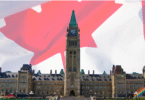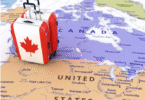A Canadian tourist visa, also known as a Temporary Resident Visa (TRV), lets foreign visitors enter Canada for a short stay. People use it for tourism, business, or visiting family. The visa usually allows a stay of up to six months. However, it does not allow you to work or live in Canada permanently.
Many people wrongly think a tourist visa is a way to move to Canada permanently. This misunderstanding can cause confusion about what the visa really allows. Staying in Canada long-term on a tourist visa without following the right immigration steps breaks Canadian law.
This article aims to clarify the role and limitations of the tourist visa.
Understanding the Canadian Tourist Visa
A Canadian Tourist Visa, also called a Temporary Resident Visa (TRV), is an official document that lets foreign visitors enter Canada for a short stay. Immigration, Refugees and Citizenship Canada (IRCC) issues the TRV as permission to visit for tourism, family visits, or some business activities. It does not allow you to work or live in Canada long-term.
The TRV usually allows a stay of up to six months. During this time, visitors can travel within Canada and take part in allowed short-term activities. However, the final length of stay is decided by the border officer when you arrive. You must leave Canada by the date given unless you get an approved extension. The visa does not allow you to work or study unless you have special permission.
The tourist visa is best for people who want to visit Canada for a short time. This includes tourists, people visiting family or friends, business travelers attending meetings or events, and those who want to explore Canada before deciding on long-term immigration. It is not meant for anyone who plans to live, work, or study in Canada permanently.
Can You Move to Canada on a Tourist Visa?
A tourist visa, or Temporary Resident Visa (TRV), allows temporary entry into Canada. It does not give legal permission to move there permanently. The TRV is for short visits, not long-term living. People with this visa must follow the rules and leave Canada before their allowed time ends.
The difference between temporary and permanent stay is very important. A temporary stay lasts only for a short time and for specific reasons like tourism, family visits, or certain business activities. Permanent residence, on the other hand, lets you live, work, and receive social benefits in Canada indefinitely. Trying to stay in Canada longer than allowed by a TRV or using the visa to become a resident breaks immigration laws.
Canadian immigration officers check visitors’ intentions when they apply and when they arrive. Applicants must prove strong ties to their home country and a clear plan to return. Officers review financial stability, travel history, and the reason for the visit. If they suspect someone might overstay or misuse the visa, they can refuse entry or remove the person from Canada.
Despite these limits, many people use the tourist visa to visit Canada before deciding to move permanently. This helps them see if the lifestyle suits them, explore different cities or provinces, and learn about job opportunities. Others visit friends or family, attend short training sessions, or do early research before applying for a study or work permit.
Requirements for a Canadian Tourist Visa
To get a Canadian Tourist Visa (Temporary Resident Visa – TRV), applicants must meet certain eligibility rules and provide all required documents. Meeting these conditions helps the application process go smoothly and increases the chances of approval.
Below is a list of the essential documents and criteria for a Canadian tourist visa:
- Completed Application Form (IMM 5257):
Applicants must fill out the Visitor Visa form accurately. The form is available online and must reflect truthful and consistent information. - Valid Passport:
The passport must be valid for at least six months beyond the intended stay in Canada. - Passport-Sized Photographs:
Provide recent passport-sized photographs that meet the specifications outlined in the official application guide. - Proof of Travel History:
Submit copies of previous visas and entry/exit stamps to demonstrate lawful international travel and compliance with visa conditions. - Proof of Funds:
Include bank statements, pay slips, or financial documents that prove you can cover all expenses during your stay in Canada. - Travel Itinerary:
Outline your planned activities in Canada. This may include a schedule of visits, sightseeing plans, and relevant booking confirmations. - Accommodation Details:
Provide documentation of your accommodation arrangements. This may include hotel reservations or a letter from a host in Canada. - Return Ticket:
Include proof of a round-trip ticket or clear evidence of plans to depart Canada at the end of your stay. - Purpose of Visit:
Clearly state your reason for visiting Canada, such as tourism, visiting family or friends, or attending an event. - Letter of Invitation (if applicable):
If invited by someone in Canada, include a signed letter detailing your relationship, reason for the visit, and the intended duration of stay. - Proof of Employment or Studies:
Submit a letter from your employer or academic institution confirming your current status, approved leave, and intention to return. - Travel Insurance (Recommended):
Though not mandatory, travel insurance is strongly advised. It should cover medical emergencies, trip cancellations, and unforeseen incidents. - Biometrics:
Depending on your nationality, you may need to visit a Visa Application Centre to provide fingerprints and a photograph. - Language Translations (if required):
If any documents are not in English or French, include certified translations along with the originals. - Visa Application Fee:
Pay the non-refundable application fee. The amount and payment methods vary by location, so consult your local visa office. - Clean Criminal Record:
Provide a police certificate or background check to confirm you have no criminal history that would render you inadmissible.
Step-by-Step Application Process
Applying for a Canadian Tourist Visa requires careful attention and following all the rules. This section explains the step-by-step process to help applicants navigate the system easily and avoid common mistakes.
Gathering Necessary Documents
Start by gathering all the documents listed in the eligibility checklist. Make sure each document is up-to-date, complete, and follows the rules set by Immigration, Refugees and Citizenship Canada (IRCC). Arrange them in a clear order to make the application process easier.
Online vs. Paper Application
Online Application
The best and fastest way to apply is online through the IRCC portal. To apply, create an account, fill out the forms, and upload scanned copies of your documents. Online applications usually process faster and let you track your status online.
Paper Application
Applicants can also apply using paper forms at a Visa Application Centre (VAC). This means mailing or delivering the documents in person. Paper applications often take longer to process and need extra steps to complete.
Choose the method based on convenience, access to digital tools, and personal preference. However, the online route provides greater efficiency and transparency.
Biometric Appointment and Interview (if required)
Depending on your nationality and past visa history, you might need to provide biometrics. This means giving your fingerprints and a photo. After you apply, you will get a Biometric Instruction Letter (BIL) if this applies to you. Book an appointment at the closest Visa Application Centre (VAC) quickly, because delays can slow down your application.
Sometimes, you may be asked to attend an interview to confirm your travel purpose or explain parts of your application. If this happens, go to the interview with all your documents and answer the questions honestly and clearly.
Waiting Time and Visa Decision
After finishing all steps, including biometrics, your application moves into the processing queue. Processing times differ by country and how many of applications there are. You can check estimated wait times on the IRCC website.
Once a decision is made, you will get a notification by email or through your online account. If approved, your passport will receive the Temporary Resident Visa (TRV) stamp, letting you enter Canada during the visa’s valid period.
Frequently Asked Questions
Can I work in Canada on a tourist visa?
No. A tourist visa (Temporary Resident Visa – TRV) does not permit you to work in Canada.
Can I study in Canada with a tourist visa?
Short-term courses lasting six months or less may be allowed without a study permit. However, for full-time or long-term academic programs, you must apply for a study permit separately.
Is it possible to extend a tourist visa while in Canada?
Yes. You can apply to extend your stay by applying for a Visitor Record before your current visa expires.
Can I bring my spouse or children with me on a tourist visa?
Yes. Family members can apply for their tourist visas. Each application is assessed independently, and each applicant must meet the eligibility criteria and submit the required documents.
Conclusion
Although the tourist visa does not lead directly to permanent residence, it can be a useful first step for those thinking about immigrating. Use your time in Canada to research, plan, and learn about legal immigration options like study permits, work permits, or Express Entry.






